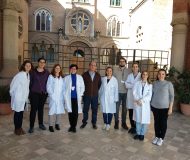

Blood levels of various molecules related to oxidative stress may be useful biomarkers in predicting the risk of ruptured abdominal aortic aneurysm. This is confirmed by a study carried out by researchers from the Research Institute of the Hospital de la Santa Creu i Sant Pau – IIB Sant Pau and the CIBER for Cardiovascular Diseases (CIBERCV) in collaboration with scientists from the Barcelona Institute for Biomedical Research (IIBB-CSIC), and the CIBER of Obesity and Nutrition (CIBEROBN) of the Rey Juan Carlos University, which has been published in the journal Antioxidants.
Abdominal aortic aneurysm (AAA) is a life-threatening condition that consists of a localized and permanent dilation of the abdominal aorta, the prevalence of which can reach 4-7% of men over 65 years of age. Over time, the aortic diameter tends to expand and the risk of rupture increases, the most serious complication of this disease, which produces extensive internal bleeding. This event is responsible for between 1% and 2% of all deaths and constitutes one of the main triggers of death in men over 70 years of age.
The implementation of ultrasound detection programs has improved the early diagnosis of this pathology, but finding new indicators for the prognosis of its evolution is key in the management of the disease. In this sense, although the incidence of rupture increases with the aortic diameter, this parameter is not in all cases a good predictor of risk, since small aneurysms can also have a poor outcome. Therefore, the identification of biomarkers in the blood to assess the progression of AAA, will play a key role in improving the recognition of patients at higher risk.
This has been the objective of this new research, which focused on analysing the prognostic value of circulating (blood) levels of various molecules related to oxidative stress and inflammation. “In order to identify new circulating biomarkers, we selected a battery of immune inflammatory and oxidative stress markers that we know are involved in the pathological mechanisms of abdominal aortic aneurysm progression,” says María Galán, researcher at the Research Institute of the Hospital de the Santa Creu i Sant Pau – IIB Sant Pau, that has led the study.
To achieve this, an analysis of the correlation of these markers with two risk parameters was carried out: the diameter of the aneurysm and the value of maximum arterial wall tension. The researchers had the participation of the Angiology, Vascular and Endovascular Surgery service of the Hospital de la Santa Creu i Sant Pau to study aneurysmal aortic samples and blood samples from 94 AAA patients, comparing them with abdominal aortic samples and blood from healthy people.
The results showed that the blood levels of superoxide anion, IgM, IgG, CD38, GDF15, S100A4, as well as its expression in the abdominal aorta of patients with AAA, were altered compared to healthy controls.
“The levels of IgG, CD38 and GDF15 were positively correlated with the diameter of the abdominal aorta and with the values of maximum wall tension, showing that they have the potential to help predict the risk of rupture and growth of the aneurysm in patients with AAA”, points out David Sánchez-Infantes, first author of the work.
“These findings suggest the usefulness of these biomarkers, which can be measured in a blood sample, to help the management of patients with aneurysm, along with other tools already used in prognosis such as aortic diameter and maximum wall tension”, the researchers conclude.
Reference article:
Sánchez-Infantes D, Nus M, Navas-Madroñal M, Fité J, Pérez B, Barros-Membrilla AJ, Soto B, Martínez-González J, Camacho M, Rodriguez C, Mallat Z, Galán M. Oxidative Stress and Inflammatory Markers in Abdominal Aortic Aneurysm. Antioxidants. (2021) https://doi.org/10.3390/antiox10040602